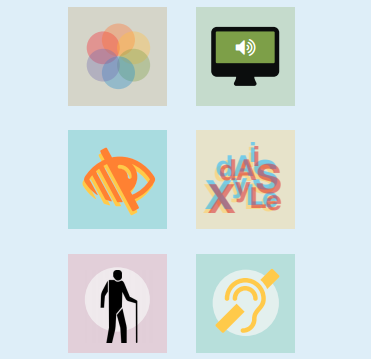
Originally published Oct. 14, 2020.
Updated May 30, 2021.
Virtual events have event planners thinking about inclusivity and accessibility in a completely different way. When we look at accessibility as removing barriers for all people, we realize the concept of accessibility doesn’t just apply to the ‘physical’ – physical barriers or physical disabilities.
Your audience will have different needs at different times, and in different circumstances. Someone’s ability to access your virtual event could be affected by their location (e.g. “I do not have wifi at home”), health (e.g. “I have a broken arm”), or equipment (e.g. “I am using an old mobile device”). Furthermore, permanent, situational, and temporary factors might make it difficult for users to access content.
Let’s look at some examples…
- Visual impairments:
- I have low vision and need to increase the text size in my browser.
- I am blind and use a screen reader.
- Auditory impairments:
- I am hard of hearing and struggle to hear most things.
- I am deaf; British Sign Language is my first language and I find English hard to read and write.
- Motor/Speech impairments:
- I have a mild motor impairment so I struggle to use a mouse with fine control.
- I have both a severe motor impairment and speech impairment and I use a switch device.
- Cognitive impairments:
- I am on the autism spectrum and have a literal understanding of text.
- My memory is not as good as it used to be and I get easily confused.
- Seizure disorders:
- I have epilepsy and my seizures can be triggered by flashing content.
- Sensory disorders:
- I am extremely sensitive to loud noises.
- Mental health considerations:
- I find it triggering to be put on the spot to answer a question, share my screen, or engage in networking activities if I have not been able to prepare to do so, in advance.
Because of these many factors, it’s important to be as forthcoming as possible with the event format and details so that the attendees know what to expect, and can plan accordingly and reach out if they require assistance.
Rather than focusing solely on the technology being used, there also needs to be an emphasis put on the different ways in which people interact with online content based on their needs!
For example, users might use a keyboard instead of a mouse, use a screen magnifier to enlarge part or all of a screen, or use voice commands to navigate a website. Resources for support should be available to support both physical and mental health considerations.
So, where should we focus our efforts?
When thinking about the different ways that people interact with online content, four main ‘needs’ come into play that need to meet the following criteria1:
- Perceivable: I need to be able to perceive the information being presented (it isn’t invisible to all of my senses).
- Operable: I need to be able to operate the platform (it doesn’t require interaction that I cannot perform).
- Understandable: I can understand the information and operation of the platform (it isn’t beyond my understanding).
- Robust: I need the content to be interpreted reliably by a wide variety of user agents (software that retrieves and presents web content), including assistive technologies.
This is still quite broad.
I’m going to break it down into a list of things to think about before, during, and after your next virtual event!
But first, it’s important to note that it will be impossible to ever think of ALL of the needs of every single person attending your event. You don’t know what you don’t know… so you have to ask! The most important thing in regards to inclusivity is making your attendees feel comfortable communicating their needs prior to the event. Many people who feel there is no option provided, will likely feel the need to figure things out for themselves or even avoid virtual events altogether.
TIP: Address accessibility in your promotional materials and let your attendees know what your commitment to accessibility and inclusivity is; how can they reach out to you if they have needs and/or questions (and anonymously if desired)!
Now, let’s get to that list shall we?!
Before the Event:
- Ensure your platform:
- Provides a comparable experience for everyone so that people can accomplish tasks in a way that suits their needs without undermining the quality of the content.
- Allows for both computer-based and phone-based audio listening/speaking.
- Is compatible with assistive technology (e.g. screen readers and both augmentative and alternative communication).
- Features are considered. Explore the accessibility features and consider the value of these features.
- Offer different ways to access video conferences, such as by phone or options for transcript and recording provided post-event. People should be able to access and interact with content in their preferred way.
- Have an accessibility point person who can assist with troubleshooting or access issues. Be sure to provide contact information for them. Ensure that mental health resources are readily available to this point person, so they are prepared in advance.
- Include detailed, step-by-step directions of how to both log in to the event and how to use the platform. Consider offering training sessions prior to the event on how to use the platform that the event will be hosted on.
- Share the format of the event (e.g. chat discussion vs. video participation vs. listening to a presentation, or something else), when/how attendees will have the opportunity to ask questions, and how long it is planned to run for.
- Provide a glossary of terms that will be used during the event and define them.
- Provide a privacy policy and accessibility policy.
- Ensure that content warnings are in place if your speakers, presenters or panelists will be discussing a potentially triggering topic or subject matter.
Remember: We’re trying to create a barrier-less experience for attendees by removing any factors that might pose as a threat or roadblock.
During the Event:
- For any written content, ensure:
- Fonts are easy to read (text is large and has good colour contrast).
- Pages are organized and uncluttered.
- Meaningful headings are used.
- Links are descriptive (e.g. ‘Next Page’, ‘Ask a Question’).
- For images/videos, ensure:
- They help explain concepts.
- Alternative text and descriptions are included and/or they are verbally described.
- Flashing or strobing animations are not used.
- For all content, ensure:
- Plain and people-first language is used (i.e. be mindful of jargon, slang, and assumed knowledge).
- Abbreviations and acronyms are explained.
- Sentences are kept short.
- Features and information are prioritized within the layout, helping attendees focus on core tasks.
- Communicate any accessibility features available during your event.
- Have your speakers say their name or be introduced when they speak, so captioners and attendees alike all know who is talking.
- Ensure that participants have the ability to opt-out of virtual activities that they are not comfortable with.
After the Event:
- Share materials in an accessible format.
- Offer your attendees the opportunity to provide feedback about the event, including accessibility, to help you prepare to plan the next one. Ensure the survey is also accessible.
- Make accessibility an ongoing, inclusive conversation in your community for all types of events.
What we mean to say is this…
Accessibility = removing barriers to access. When we think about how this relates to virtual events, it is critical to identify all of the possible ways in which people can interact with digital content. Once that has been established, it’s all about supporting people in digesting that content in the way that feels most comfortable for them. Afterall, the motivation that inspired one’s content to be shared must inspire one’s motivation to share it with all, barrier-free!
Our sources of information include:
- 1https://www.w3.org/TR/UNDERSTANDING-WCAG20/intro.html
- https://rootedinrights.org/how-to-make-your-virtual-meetings-and-events-accessible-to-the-disability-community/
- https://www.endabusepwd.org/solutions/inclusive-movement/enhance-the-accessibility-of-virtual-events/requesting-feedback-on-your-webinars-accessibility/
- https://www.deque.com/blog/virtual-meeting-accessible-zoom/
- https://www.arts.gov/accessibility/accessibility-resources/resources-to-help-ensure-accessibility-for-your-virtual-events-for-people-with-disabilities
- https://www.assistiveware.com/learn-aac/7-ways-to-include-aac-users-in-conversation
- https://inclusivedesignprinciples.org
